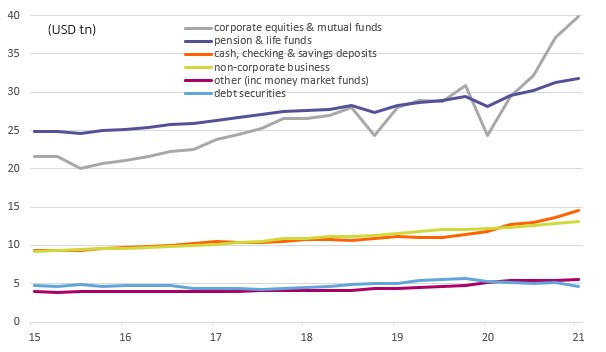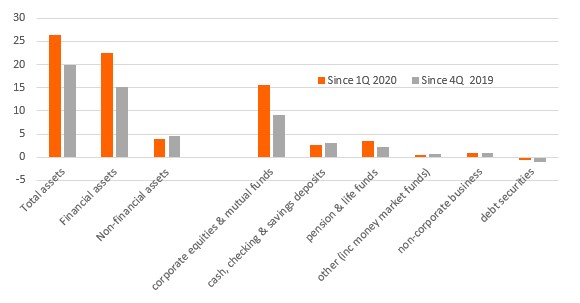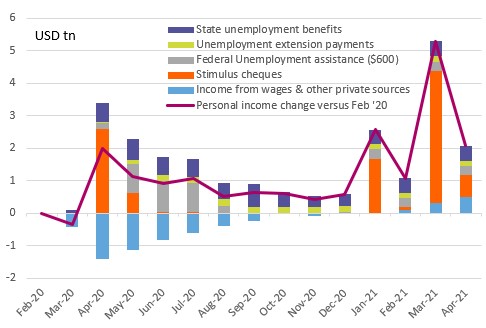US household wealth surged $20tn despite the pandemic
The human and economic cost of the pandemic is apparent for all to see yet US household wealth has still managed to increase by $20tn since 4Q19. From the equity market trough in March last year, wealth has increased $26tn thanks to massive support from both government and the Federal Reserve
| $154 trillion |
US household wealth in 1Q21 |
The only way is up!
The Federal Reserve Flow of Funds data for 1Q21 shows some remarkable figures. Despite the pandemic and the resulting lockdowns, business closures and, at its worst point, the loss of more than 20 million jobs, the US household balance sheet improved massively over the past four quarter with total wealth now standing at $154.2tn. Before the pandemic hit total assets ended 2019 at $134.3tn, falling to $127.8tn at the end of March 2020 when financial markets were in capitulation mode.
Non-financial assets – primarily real estate, but it also includes things such as cars, jewellery and equipment – now totals $44.6tn while financial assets total $109.6tn. The largest categories here are pension entitlements ($29.9tn), corporate equities ($28.2tn), small business equity ($13.1tn), mutual funds ($11.6tn) and time and savings deposits ($11.2tn).
Liabilities are “just” $17.2tn and are primarily mortgage and consumer loans, which leaves household net worth is $136.9tn. This is equivalent to 620% of US GDP.
US household financial assets (2015-2021)

The wealthy are getting much, much wealthier
The biggest contribution to the financial wealth gains came from corporate equities and mutual funds due primarily to risk appetite rebounding and equity markets surging higher on unprecedented Federal Reserve and government stimulus. The same reasons led to strong performances for pension and life insurance funds. Conversely, the value of debt security holdings has actually fallen.
The majority of the increases in wealth will have been experienced by higher income and already wealthy households since they will have been heavily invested in these asset classes already. Moreover, higher income and wealthier households spend proportionatly more on services and “experiences” such as travel, eating out, theatre, cinema – things that Covid containment measures have prevented. Consequently, we are likely to have seen a significant increase in unplanned saving amongst this grouping with the money instead put into various financial and physical assets.
There was also a substantial increase in wealth within cash, checking and savings deposits. Given such low interest rates this was overwhelmingly due to people putting more and more money into these accounts – up $2.7tn since 1Q20 and up $3.2tn since 4Q19!
Change in household assets between 1Q21 and 1Q20 and 4Q19 (USD trillions)

Low income households have also improved their financial position
Lower income households will also have contributed significantly to this increase. Government stimulus checks of $1200, $600 and $1400 combined with uprated and extended unemployment benefits contributed to huge increases in household incomes over the past 14 months as can be seen in the chart below. An NBER paper calculated that 69% of unemployment benefit recipients actually earned more money being unemployed than when they were working. The median recipient received 134% of their previous after-tax compensation.
With opportunities for spending being limited due to Covid containment measures it is likely that not all of these income gains have been spent. Indeed, monthly data suggests outstanding credit card balances have been paid down and are currently at four-year lows and we strongly suspect more savings will have been accumulated as well.
Change in annualised US household incomes versus February 2020

More ammunition to spend
With employment gradually coming back and evidence of higher income growth coming through this means consumer confidence has strong underpinnings. With more options for people to spend money as the economy re-opens this massive accumulation of wealth only adds to the potential spending ammunition of the household sector. In an environment where supply constraints persist this adds another reason to argue that the demand growth in the economy is likely to outpace the supply side capacity. Another argument for inflation staying higher for longer.
Download
Download articleThis publication has been prepared by ING solely for information purposes irrespective of a particular user's means, financial situation or investment objectives. The information does not constitute investment recommendation, and nor is it investment, legal or tax advice or an offer or solicitation to purchase or sell any financial instrument. Read more
